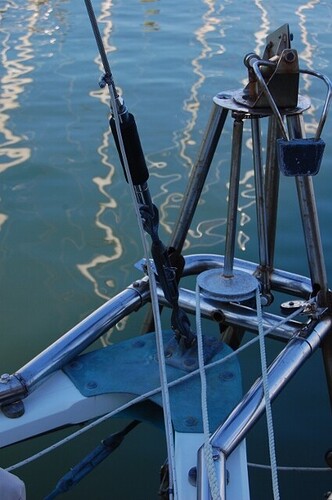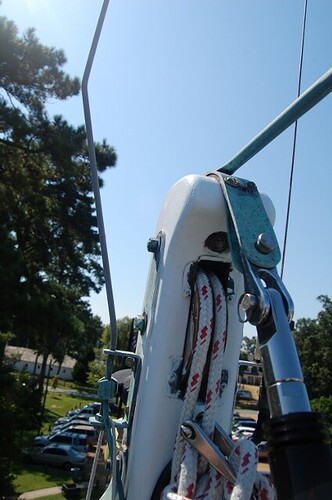- Antenna length
Aiming for a longer antenna length by placing the lower backstay insulator as low as possible is like chasing a mirage.
That’s because the entire run of wire, the GTO-15 feed wire from ATU to backstay + the insulated run of the backstay, is the length of the antenna.
If the lower insulator was placed 2 metres above the turnbuckle, you’d need a longer feed wire. And the total of feed wire + backstay would be not much different than if the lower insulator was placed just above the turnbuckle.
In practice, no one runs the bare minimum of feed wire. That’s to allow for what Dan reported - the need every year or three, to snip off corroded wire from the feed wire.
If you used coax instead of GTO-15 as your feed wire, the picture would be different.
Zygote has 3 metres of GTO-15 feed wire + 8.7 metres of insulated backstay, giving a total antenna aperture very close to 12 metres. Theoretically the ATU should be less successful, because of antenna resonance, tuning in the 24 metre and 12 metre radio bands (12MHz and 25 MHz). We’ve not noticed that (and, like Dan, our feed wire gets a little shorter every now and then).
- Protecting the crew from RF
Voice work is different from PACTOR modem work. A PACTOR modem drives the SSB transceiver quite hard (in terms of transmission power). Silence between words makes up a big chunk of voice work.
The result is that for voice work, you likely only need worry about RF burns from someone touching the antenna when you’re transmitting. Which, as Rod points out, is unlikely.
But PACTOR work makes it worthwhile to consider the RF bathing the cockpit.
Typical of big Government Euro-socialists, the nanny state of Australia came up with guidelines and regulations about a decade ago. If you’re interested, point your browser to http://www.arpansa.gov.au/Publications/Codes/rps3.cfm and download the Standard (RPS No. 3, about 2.1 MB) from the top link.
We went to the trouble of modelling the RF transmissions on Zygote (backstay at 63 deg to the horizontal, lower insulator 2.8 m above sea level, peak transmission power, head of a person seated at the tiller located 1.25 m from the antenna at 111.5 degrees from the line of the backstay … etc you know the drill) and produced a document, which is likely on board in the folder with Zygote’s apparatus license, to cover ourselves.
We used free software, written by hams for hams, to model the RF propagation from the antenna. If you’re interested, your favorite search engine will find it. I’ve forgotten many of the details (eg I’ve forgotten whether it’s a good or a bad thing to have your antenna closer to the water surface; I’ve a rough memory that keeping my head more than 1.25 m from the antenna is a good thing).
The document said we would never let a member of the public stand on the water surface within two metres of the transom when transmitting. And similar motherhood statements. No govt inspector has asked for that document (but they could! all that is necessary is a couple of complaints from members of the public).
And to protect ourselves, we adopt a practice of minimising our presence in the cockpit when doing PACTOR work. Meaning minimising crew in the cockpit and keeping them forward and on port (the ATU and feed wire run on starboard).
Cheers
Bil

